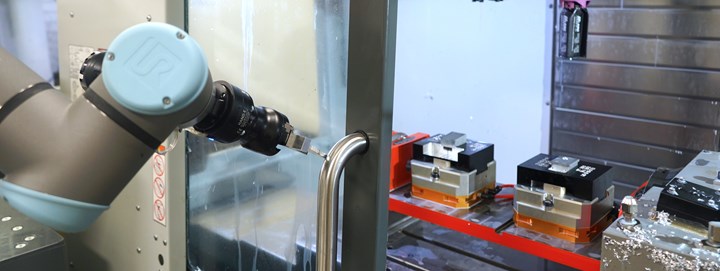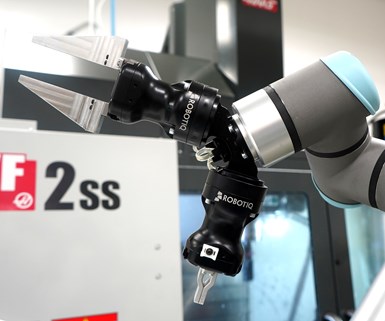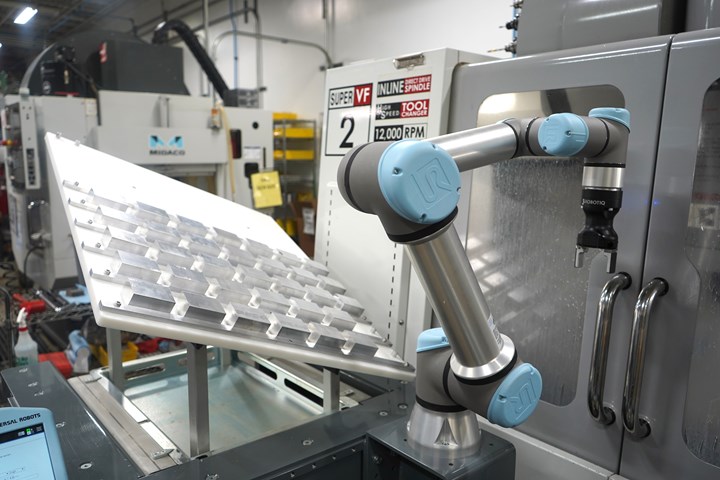Shop Doubles Production Capacity with Robotic Machine Tending
In an unusual case of workers pleading for the adoption of machine-tending robots, Fusion OEM has realized great increases in capacity while freeing up machinists to more complex tasks.
Share





In a time when concern about robots replacing human labor is common, it’s less common to hear stories about shop employees advocating for robots to their managers. That is Fusion OEM’s story. An effort led by employees resulted in the adoption of multiple Universal Robots with end effectors from Robotiq, lowering job costs.
Always looking for inspiration from his peers in the industry, Fusion’s head machinist, Davin Erickson, had been following CNC machining channels on Instagram and YouTube for years. He was impressed when he first saw a robot operating a machine without caging. Given the shop’s difficulties finding and hiring new employees as well as its past experiences with bulky industrial robots, Mr. Erickson’s interest remained piqued.

Robotiq’s Dual-Hand-E adaptive grippers move machined parts from one vise to another in one of Fusion OEM’s 14 CNC machines.
“We then began to see these collaborative robots everywhere on social media and at trade shows,” he recalls. “We tried to convince our CEO that this would be great for our factory. It took a few tries, but since it was very difficult to find good human help around here, we finally welcomed our first robot in the summer of 2018.”
Automating Machine-Tending Operations
Empowering his people is what made CEO Craig Zoberis decide to go ahead with Universal Robots and Robotiq as partners for the shop’s collaborative robotics project. Mr. Zoberis remembers reading “Lean Robotics,” a book by Robotiq CEO and co-founder Samuel Bouchard. He describes one of the arguments of the book: that robots help fulfill human labor potential. “Instead of having our staff loading and unloading machines every 10 minutes, they can focus on machine programming and any other value-added tasks,” he says.
Four robots were deployed at Fusion OEM within less than a year. The automated application runs as follows:
- A UR5e or UR10e robot arm uses Robotiq’s Hand-E adaptive gripper (single or dual setup) to pick up a part presented on a custom nesting system.
- The gripper opens the door and inserts the part into the chucking system using Robotiq’s Force Copilot software.
- The robot then closes the door and sends a signal to the machine to start the cycle.

A Universal Robots UR10e closes the door of a machining center.
The Hand-E adaptive gripper is designed for precise part insertion with customizable fingertips. “We’re able to connect the grippers directly to the robot’s wrist, get feedback on position and force, and know if there’s a part where there should be one and if it’s the right part,” says R&D Manager Stephen Milchuck, who only needed a few minutes to begin operating the Hand-E with its software interface when he first tried it.

Fusion OEM customized one of its two gripper’s fingertips and mounted them on the Hand-E’s custom fingertips sliders in a just few minutes.
Inserting a part into a machine chuck requires many programming steps, especially when using the robot’s force control for better accuracy and repeatability. “The program was getting pretty big because we were trying to have the robot accomplish all movements through different axes to place the part,” recalls Jacob Miller, engineering manager at Fusion OEM. “Then by adding one or two lines of code through Force Copilot , we let the software generate all the part positioning in a much faster and simpler way.”
The Numbers Don’t Lie
This new application quickly proved its value. Chief Operating Officer Ken Chess started gathering data on the company’s most frequently recurring order. “We often do lots of around 500 parts for this customer. Before the robots arrived, it would take almost six days to deliver. But now with the cobots running overnight, it takes three days, and our defect rate has gone down, since robots make fewer mistakes than even the best machinists out there,” he says.
Fusion OEM relies on Robotiq’s Insights monitoring software to send alerts to employees’ phones and emails if production stops for any reason. If an employee is off-site, they can log in remotely to solve the problem. “We also get predictive signals that tell us when a raw part supply is almost empty,” says Mr. Chess. “With all these tools helping us maximize runtime, we get a much better margin on the job.” Using the data from Insights, he concludes that running a job on a given machine with a Universal Robot is four times cheaper than operating manually.

Fusion OEM’s custom part nesting system stands beside a Universal Robots UR10e with a single Robotiq Hand-E gripper.
Meanwhile, machinist Brian Wroblesky says he can spend more time on machine programming without having to load them. “There’s more consistency in the loading and unloading of the parts. It’s taken away some of the human error,” he says.
How Human Workers Have Reacted to Robotic Workers
Ease of use is another major plus for Fusion OEM employees. Production supervisor Chris Wenzel had seen a lot of industrial robots before, and was impressed with the Robotiq/Universal Robots offering: “The programming, the interface — everything is easier. Now we talk about each program in terms of minutes, rather than hours.”
With regard to morale, humans and robots at Fusion are getting along pretty well. For machinist Jenny Kim, these robots have become as normal as any other piece of equipment: “I call them ‘brobots’ because they’re like your brothers. You have to treat the machines kindly. Respect them, and they respect you back.”
Work is far from over for the Fusion OEM team. The shop’s goal by early 2020 is to have a robot tending all 14 of its Haas CNC machines. Mr. Zoberis relies on the lean robotics methodology to standardize his robotics project and scale faster. “I wish I had read ‘Lean Robotics’ earlier. It would have saved me so much time and money spent on design. We have since learned to start simple, get small wins and stop overcomplicating things.”
Within the next year, the company hopes to double production capacity, increase machine uptime and — above all — continue to maximize human potential.
Related Content
Investing in Automation, Five-Axis to Increase Production Capacity
To meet an increase in demand, this shop invested heavily in automation solutions and five-axis machines to ramp up its production capabilities.
Read MoreCutting Part Programming Times Through AI
CAM Assist cuts repetition from part programming — early users say it cuts tribal knowledge and could be a useful tool for training new programmers.
Read MoreIncreasing Productivity with Digitalization and AI
Job shops are implementing automation and digitalization into workflows to eliminate set up time and increase repeatability in production.
Read MoreHow to Accelerate Robotic Deburring & Automated Material Removal
Pairing automation with air-driven motors that push cutting tool speeds up to 65,000 RPM with no duty cycle can dramatically improve throughput and improve finishing.
Read MoreRead Next
If at First Your CNC Machine Shop Doesn’t Succeed with Robots, Automate Again
Alexandria Industries struggled with its first robotic machining cell. However, the aluminum extrusion components manufacturer — now with more than 20 robots — discovered that by simplifying and standardizing its automation strategy, it could reap the benefits of unattended machining even for relatively low batch sizes.
Read MoreRegistration Now Open for the Precision Machining Technology Show (PMTS) 2025
The precision machining industry’s premier event returns to Cleveland, OH, April 1-3.
Read MoreBuilding Out a Foundation for Student Machinists
Autodesk and Haas have teamed up to produce an introductory course for students that covers the basics of CAD, CAM and CNC while providing them with a portfolio part.
Read More




















.png;maxWidth=300;quality=90)








.png;maxWidth=970;quality=90)